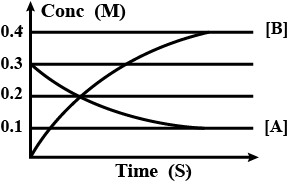Question
Question: The figure shows the change in concentrations of species \(A\) and \(B\) as a function of time. The ...
The figure shows the change in concentrations of species A and B as a function of time. The equilibrium constant Kc for the reaction: A(g)→2B(g) is:

A. Kc>1
B. Kc<1
C. Kc=1
D. Data insufficient
Solution
The equilibrium constant for a reaction can be calculated from the concentration of the product(s) and the reactant(s) at the stage when the reaction reaches the state of equilibrium, and the concentration of both product(s) and reactant(s) become constant. Time, here, does not play a role, and hence, is not considered.
Complete step by step answer:
In the given reaction, A(g)→2B(g) , there is only one reactant, A, and only one product, B. The concentration of species A decreases with time as it is the reactant, and the concentration of species B increases with time as it is the product.
The equilibrium constant for a reaction with only one reactant and one product is given by the formula:
Kc=[Reactant]y[Product]x
Where x represents the stoichiometric coefficient of the product;y represents the stoichiometric coefficient of the reactant.To calculate the equilibrium constant, we have to consider the concentration of the species at the end of the reaction, when their concentrations become constant and show no change with time. The concentration, as mentioned, is represented on the y−axis as M. So, we will take note of the values of M on the y−axis of the graph to determine the concentration of A and B. From the graph, we can see that the concentration of A decreases from 0.3 to 0.2, and then becomes constant at 0.1. So, the concentration of A at equilibrium is 0.1. For B, the concentration increases from 0.1 to 0.4, and finally becomes constant at it. So, the concentration of B at equilibrium is 0.4. From the reaction, the stoichiometric coefficient of B is known to be 2, and that of A is known to be 1. Therefore, the equilibrium constant, Kc for the given reaction can be calculated as follows:
Kc=[A][B]2
⇒Kc=[0.1][0.4]2=1.6
For the given question, we have to determine whether the value of Kc is greater than, less than, or equal to 1. Since 1.6>1, the value of Kc>1.
So, the correct answer is Option A.
Note: Function of time:The function of time indicates that the concentration of a reactant and the product formed by it changes with time. Time has no usage in determining the equilibrium constant of a reaction. In a first-order reaction, the rate depends on the concentration of only 1 reactant.
